Rahaf Aljundi
When Data Falls Short: Grokking Below the Critical Threshold
Nov 06, 2025Abstract:In this paper, we investigate the phenomenon of grokking, where models exhibit delayed generalization following overfitting on training data. We focus on data-scarce regimes where the number of training samples falls below the critical threshold, making grokking unobservable, and on practical scenarios involving distribution shift. We first show that Knowledge Distillation (KD) from a model that has already grokked on a distribution (p1) can induce and accelerate grokking on a different distribution (p2), even when the available data lies below the critical threshold. This highlights the value of KD for deployed models that must adapt to new distributions under limited data. We then study training on the joint distribution (p1, p2) and demonstrate that while standard supervised training fails when either distribution has insufficient data, distilling from models grokked on the individual distributions enables generalization. Finally, we examine a continual pretraining setup, where a grokked model transitions from p1 to p2, and find that KD both accelerates generalization and mitigates catastrophic forgetting, achieving strong performance even with only 10% of the data. Together, our results provide new insights into the mechanics of grokking under knowledge transfer and underscore the central role of KD in enabling generalization in low-data and evolving distribution settings.
Efficient Few-Shot Continual Learning in Vision-Language Models
Feb 07, 2025Abstract:Vision-language models (VLMs) excel in tasks such as visual question answering and image captioning. However, VLMs are often limited by their use of pretrained image encoders, like CLIP, leading to image understanding errors that hinder overall performance. On top of that, real-world applications often require the model to be continuously adapted as new and often limited data continuously arrive. To address this, we propose LoRSU (Low-Rank Adaptation with Structured Updates), a robust and computationally efficient method for selectively updating image encoders within VLMs. LoRSU introduces structured and localized parameter updates, effectively correcting performance on previously error-prone data while preserving the model's general robustness. Our approach leverages theoretical insights to identify and update only the most critical parameters, achieving significant resource efficiency. Specifically, we demonstrate that LoRSU reduces computational overhead by over 25x compared to full VLM updates, without sacrificing performance. Experimental results on VQA tasks in the few-shot continual learning setting, validate LoRSU's scalability, efficiency, and effectiveness, making it a compelling solution for image encoder adaptation in resource-constrained environments.
Personalization Toolkit: Training Free Personalization of Large Vision Language Models
Feb 04, 2025Abstract:Large Vision Language Models (LVLMs) have significant potential to deliver personalized assistance by adapting to individual users' unique needs and preferences. Personalization of LVLMs is an emerging area that involves customizing models to recognize specific object instances and provide tailored responses. However, existing approaches rely on time-consuming test-time training for each user and object, rendering them impractical. This paper proposes a novel, training-free approach to LVLM personalization by leveraging pre-trained vision foundation models to extract distinct features, retrieval-augmented generation (RAG) techniques to recognize instances in the visual input, and visual prompting methods. Our model-agnostic vision toolkit enables flexible and efficient personalization without extensive retraining. We demonstrate state-of-the-art results, outperforming conventional training-based approaches and establish a new standard for LVLM personalization.
The Phantom Menace: Unmasking Privacy Leakages in Vision-Language Models
Aug 02, 2024Abstract:Vision-Language Models (VLMs) combine visual and textual understanding, rendering them well-suited for diverse tasks like generating image captions and answering visual questions across various domains. However, these capabilities are built upon training on large amount of uncurated data crawled from the web. The latter may include sensitive information that VLMs could memorize and leak, raising significant privacy concerns. In this paper, we assess whether these vulnerabilities exist, focusing on identity leakage. Our study leads to three key findings: (i) VLMs leak identity information, even when the vision-language alignment and the fine-tuning use anonymized data; (ii) context has little influence on identity leakage; (iii) simple, widely used anonymization techniques, like blurring, are not sufficient to address the problem. These findings underscore the urgent need for robust privacy protection strategies when deploying VLMs. Ethical awareness and responsible development practices are essential to mitigate these risks.
Imperfect Vision Encoders: Efficient and Robust Tuning for Vision-Language Models
Jul 23, 2024Abstract:Vision language models (VLMs) demonstrate impressive capabilities in visual question answering and image captioning, acting as a crucial link between visual and language models. However, existing open-source VLMs heavily rely on pretrained and frozen vision encoders (such as CLIP). Despite CLIP's robustness across diverse domains, it still exhibits non-negligible image understanding errors. These errors propagate to the VLM responses, resulting in sub-optimal performance. In our work, we propose an efficient and robust method for updating vision encoders within VLMs. Our approach selectively and locally updates encoders, leading to substantial performance improvements on data where previous mistakes occurred, while maintaining overall robustness. Furthermore, we demonstrate the effectiveness of our method during continual few-shot updates. Theoretical grounding, generality, and computational efficiency characterize our approach.
Controlling Forgetting with Test-Time Data in Continual Learning
Jun 19, 2024Abstract:Foundational vision-language models have shown impressive performance on various downstream tasks. Yet, there is still a pressing need to update these models later as new tasks or domains become available. Ongoing Continual Learning (CL) research provides techniques to overcome catastrophic forgetting of previous information when new knowledge is acquired. To date, CL techniques focus only on the supervised training sessions. This results in significant forgetting yielding inferior performance to even the prior model zero shot performance. In this work, we argue that test-time data hold great information that can be leveraged in a self supervised manner to refresh the model's memory of previous learned tasks and hence greatly reduce forgetting at no extra labelling cost. We study how unsupervised data can be employed online to improve models' performance on prior tasks upon encountering representative samples. We propose a simple yet effective student-teacher model with gradient based sparse parameters updates and show significant performance improvements and reduction in forgetting, which could alleviate the role of an offline episodic memory/experience replay buffer.
Annotation Free Semantic Segmentation with Vision Foundation Models
Mar 14, 2024Abstract:Semantic Segmentation is one of the most challenging vision tasks, usually requiring large amounts of training data with expensive pixel-level annotations. With the success of foundation models and especially vision-language models, recent works attempt to achieve zero-shot semantic segmentation while requiring either large scale training or additional image/pixel-level annotations. In this work, we build a lightweight module on top of a self-supervised pretrained vision encoder to align patch features with a pre-trained text encoder. Importantly, we generate free annotations for any semantic segmentation dataset using existing foundation models and train our alignment module cost free. We use CLIP to detect objects and SAM to generate high quality object masks. Our approach can bring language-based semantics to any pre-trained vision encoder with minimal training. Our module is lightweight, uses foundation models as a sole source of supervision and shows impressive generalization capability from little training data with no annotation.
Continual Learning: Applications and the Road Forward
Nov 21, 2023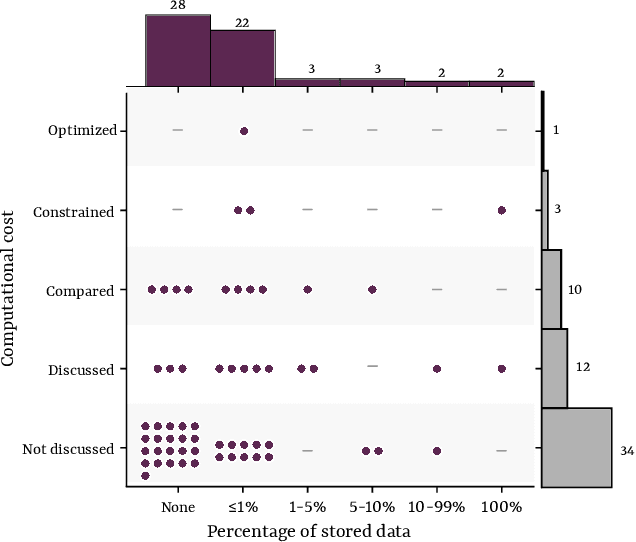
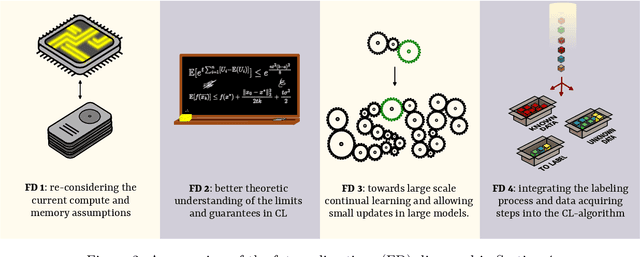
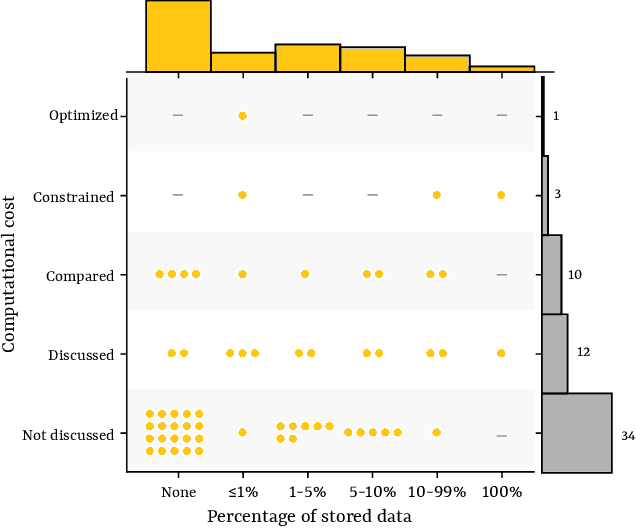
Abstract:Continual learning is a sub-field of machine learning, which aims to allow machine learning models to continuously learn on new data, by accumulating knowledge without forgetting what was learned in the past. In this work, we take a step back, and ask: "Why should one care about continual learning in the first place?". We set the stage by surveying recent continual learning papers published at three major machine learning conferences, and show that memory-constrained settings dominate the field. Then, we discuss five open problems in machine learning, and even though they seem unrelated to continual learning at first sight, we show that continual learning will inevitably be part of their solution. These problems are model-editing, personalization, on-device learning, faster (re-)training and reinforcement learning. Finally, by comparing the desiderata from these unsolved problems and the current assumptions in continual learning, we highlight and discuss four future directions for continual learning research. We hope that this work offers an interesting perspective on the future of continual learning, while displaying its potential value and the paths we have to pursue in order to make it successful. This work is the result of the many discussions the authors had at the Dagstuhl seminar on Deep Continual Learning, in March 2023.
Incremental Object-Based Novelty Detection with Feedback Loop
Nov 15, 2023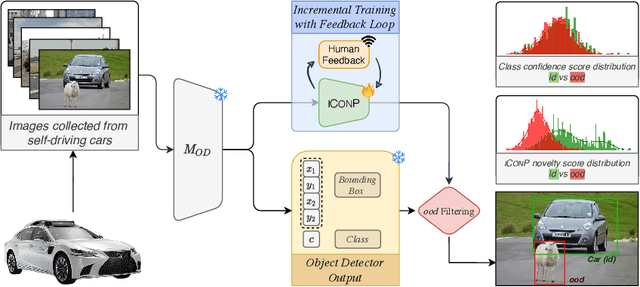
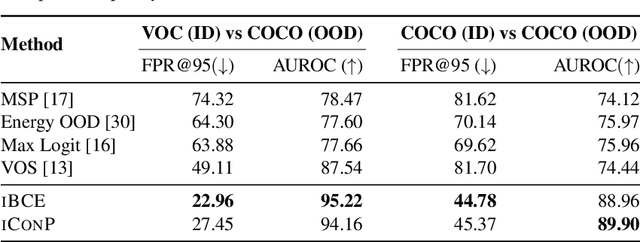


Abstract:Object-based Novelty Detection (ND) aims to identify unknown objects that do not belong to classes seen during training by an object detection model. The task is particularly crucial in real-world applications, as it allows to avoid potentially harmful behaviours, e.g. as in the case of object detection models adopted in a self-driving car or in an autonomous robot. Traditional approaches to ND focus on one time offline post processing of the pretrained object detection output, leaving no possibility to improve the model robustness after training and discarding the abundant amount of out-of-distribution data encountered during deployment. In this work, we propose a novel framework for object-based ND, assuming that human feedback can be requested on the predicted output and later incorporated to refine the ND model without negatively affecting the main object detection performance. This refinement operation is repeated whenever new feedback is available. To tackle this new formulation of the problem for object detection, we propose a lightweight ND module attached on top of a pre-trained object detection model, which is incrementally updated through a feedback loop. We also propose a new benchmark to evaluate methods on this new setting and test extensively our ND approach against baselines, showing increased robustness and a successful incorporation of the received feedback.
OOD Aware Supervised Contrastive Learning
Oct 03, 2023Abstract:Out-of-Distribution (OOD) detection is a crucial problem for the safe deployment of machine learning models identifying samples that fall outside of the training distribution, i.e. in-distribution data (ID). Most OOD works focus on the classification models trained with Cross Entropy (CE) and attempt to fix its inherent issues. In this work we leverage powerful representation learned with Supervised Contrastive (SupCon) training and propose a holistic approach to learn a classifier robust to OOD data. We extend SupCon loss with two additional contrast terms. The first term pushes auxiliary OOD representations away from ID representations without imposing any constraints on similarities among auxiliary data. The second term pushes OOD features far from the existing class prototypes, while pushing ID representations closer to their corresponding class prototype. When auxiliary OOD data is not available, we propose feature mixing techniques to efficiently generate pseudo-OOD features. Our solution is simple and efficient and acts as a natural extension of the closed-set supervised contrastive representation learning. We compare against different OOD detection methods on the common benchmarks and show state-of-the-art results.
 Add to Chrome
Add to Chrome Add to Firefox
Add to Firefox Add to Edge
Add to Edge